Reckoning With Joni Mitchell’s Genius and Flaws
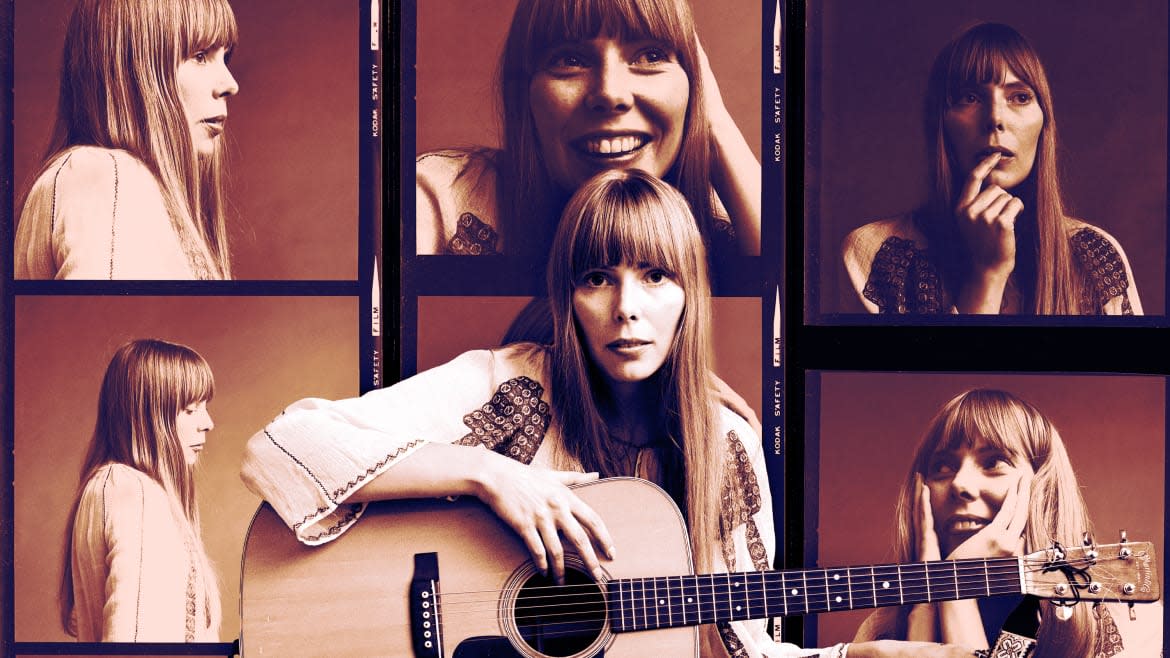
More than any other artist from the Golden Era of rock ‘n’ roll, Joni Mitchell has captured the imaginations of music fans of every age, gender, and race in the 2020s. And biographer Ann Powers is pretty sure she knows why.
“What I love about Joni Mitchell that I tried to represent in this book is her tenacity, her stubbornness, and her absolute willingness to smack down anyone who she feels is feeding bullshit to her or anyone else,” Powers tells The Daily Beast. “Her idiosyncrasies, her neuroticism—those are the qualities we love in her and are the very things that make her such a rich, complex artist and a wonderful rebel soul. The difficulty is what we love.”
It's true. And in the wake of carefully curated reissues of her studio albums and deep archival dives into both the earliest days and breakout moments of Mitchell’s storied career, she is as present in our lives today as she has been in almost half a century. The 80-year-old has even managed to return to the stage—after suffering a brain aneurysm that left most fans thinking she would never perform again, she made a surprise appearance at the Newport Folk Festival in 2022, followed by a concert in Seattle last summer and an appearance at the Grammys earlier this year. She’ll headline a Hollywood Bowl concert this October, and there are more reissues of her music on the way, plus an excellent new podcast series that focuses on her singular artistry and vast legacy.
Joni Mitchell Makes Grammy Performance Debut With ‘Both Sides Now’
Powers, whose new book, Travelling: On the Path of Joni Mitchell, delves deep not only into the whos and whats of Mitchell’s remarkable, often contrary journey, but also the whys and hows. Along the way, we meet a driven, ambitious, and often irascible artist who is, first and foremost, just that: an artist, in the truest sense of the word.
Powers spoke to The Daily Beast about the highlights and lowlights of the Canadian legend’s life and career, including her early bout with polio, the misogyny she faced as part of the fabled Laurel Canyon music scene, her unapologetic donning of Blackface, and how she’s carefully piloted her remarkable legacy.
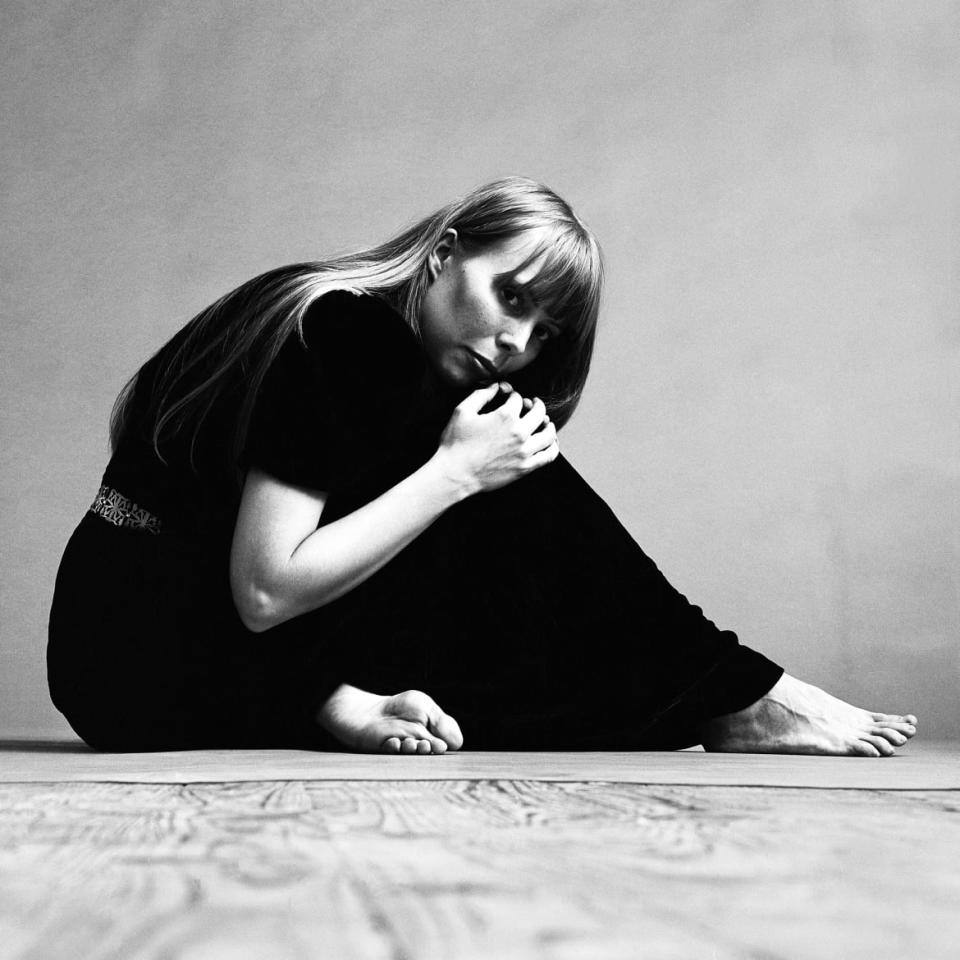
Joni Mitchell posing for Vogue magazine in November 1968.
Your book comes at a really crucial time. Joni Mitchell has raised her profile, a lot of original fans are rediscovering her, and she’s finding a whole new audience in young people. Your take is very much a Joni Mitchell biography for this moment. And it’s rightly, I would argue, elevating her as an artist on par with Bob Dylan in her significance and artistry. Like Dylan, there’s this sense of restless creativity.
Absolutely. I mean, spoiler alert, the book ends with this idea that, ultimately, the defining characteristic of Joni Mitchell is curiosity and the desire to push herself into new realms, both in terms of her life story and in terms of her art. Any superficial overview of Joni Mitchell’s career is going to deal with that, but getting deeply into all the different periods of her music—going from her very early days as a folk artist, through the Laurel Canyon period, into the jazz period, and then the ’80s, with her experiments with synthesizers. And how, even in the ’90s and 2000s, she’s continuing to explore new technologies and find so much reward in working with different collaborators. I think that is really the hallmark of a great artist, being open like that.
I think more casual fans will want to read the book for the whole Laurel Canyon era and her relationship with the men in that scene. There’s real insight into her relationships with David Crosby and Graham Nash, and later James Taylor. I loved the way you dug into the Rolling Stone archive and you were able to show how they weren’t very kind to Joni, but how they also weren’t kind to Stephen Stills either.
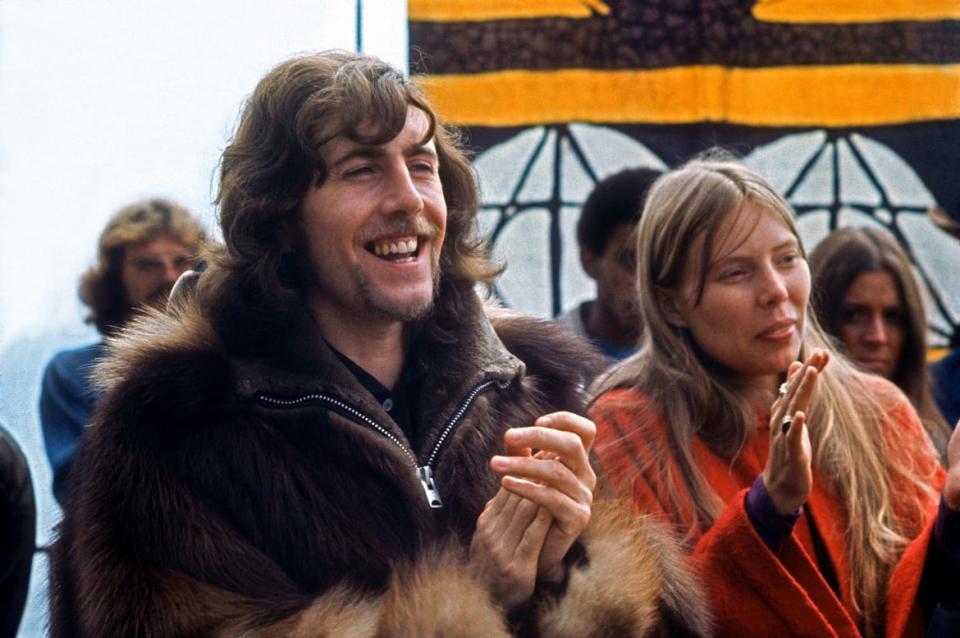
Graham Nash and Joni Mitchell during an act at the Big Sur Folk Festival at the Esalen Institute Sept. 14-15, 1969 in Big Sur, California.
No, they were mean to him. They were mean to all of them, actually.
But I think because she was a woman, and because we’re looking through 2024 eyes, it stands out that they say she’s the “old lady” of the scene, and that Charles Manson, no less, is the “old man,” which you point out to great effect. Talk a little bit about her place in the Laurel Canyon scene, when suddenly she’s being recognized as an artist in her own right. She’s pretty self-assured at a young age when she hasn’t had much success.
Well, I think you have to look all the way back to her youth, before she even left Canada, to understand the roots of Joni Mitchell’s ambition. David Yaffe, in his book, attributes her drive to her surviving polio as a child. I kind of agree with Michelle Mercer, who has written that, actually, her ambition was inherent in her and has a lot to do with that feeling of confinement that she had growing up in suburban/semi-rural Canada, and really wanting to get out.
But I think it’s also very important to think about Joni Mitchell as someone who’s always called herself a painter first, not only because of how that recasts how we understand her music and her compositional style, but what that does to her ambition. Because she considered Picasso her peer and her goal post from the time she was in high school. I mean, she was rocking with the greats at the very beginning. And I think that intention’s within her, and we hear that in the songs, but also, having this core belief that she could achieve that kind of greatness.
And so I think she looked around her at the folk scene and saw a lot of inspiration, but also saw a lot of silliness. By the time she gets to Laurel Canyon, she’s already gone through a few phases of honing her ambitions. She’s had her encounter with Leonard Cohen, a man who is equally attuned to greatness and desirous of being seen as great; someone who considered himself, and was, a poet. She has had Judy Collins interpret her music in ways that proves it could be successful commercially, so she’s being lifted up already. And then David Crosby, among his many fine attributes, was kind of a P.T. Barnum figure. He could sense talent, and he could sense what was going to impress other people and wow other people. And he saw that immediately in Joni.
And yet, she’s in the room when Crosby, Stills & Nash is happening and, as you point out, it doesn’t even occur to them to ask her to join, does it?
No! It might have been my editor, Anna Montague, who’s 30, who asked me, “Why didn’t she just join the group?” Because now, it feels like a very natural question. At the time, as I think my Laurel Canyon chapter shows, even though the Mamas & the Papas were the most commercially successful group, and a mixed-gender group, it just wasn’t how the dudes in the scene were thinking. And not only that scene. It was fairly rare to see women in bands. When I talked to David Crosby, he did say, “Why didn’t we have her in the group? Wow, that was a missed opportunity.” This was much later in life. He was playing with women in his band, and learning a lot, and he was in kind of atonement mode, I think, saying, “I made some bad decisions, and one of them was not asking Joni to be in the group.” That said, she may have said no.
I think she would have.
She’s not really a group-type person.
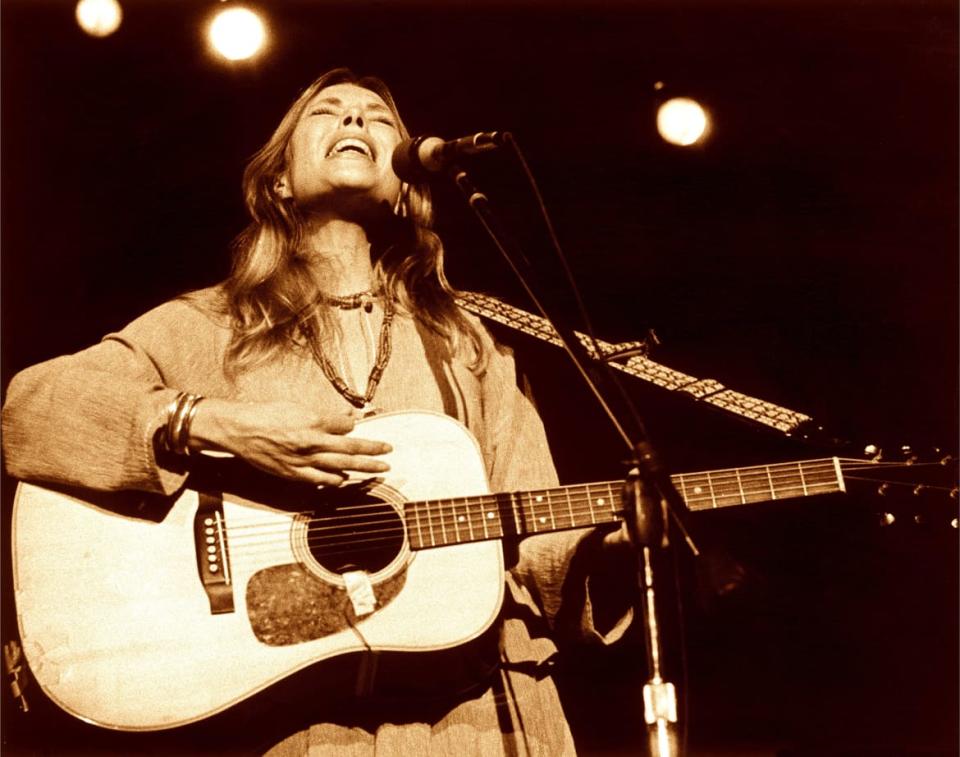
Joni Mitchell.
There is that built-in misogyny in that era. For instance, you have this great scene where Joni’s working with this unique tuning and chord on the guitar, and then she goes into the kitchen and her partner at the time, Graham Nash, steals the tuning and writes a song around it! And, you say, he probably went in and said to her, “Look what I just did!” I thought that encapsulated not just him, but also a lot of the men she had to constantly deal with. Now, of course, they’ve changed the narrative in subtle ways to make themselves the hero.
That’s true. And I’m not saying Joni hasn’t done that herself. If you were to talk to some of her exes, you’d probably get similar stories. But the fact is that that story comes from Graham’s own memoir. Reading it myself, it was like, wow. That’s such a typical “Shakespeare’s sister” kind of thing. Where it’s like, oh, you just left this for me here, thank you.
Let’s talk about Art Nouveau and Joni’s use of Blackface. As you say, almost everybody, whether they’re a fan or they’re a biographer, deals with it with kid gloves. As a reader, I’ve always wanted more. Talk a little bit about the arc of your relationship with her use of Blackface, because it seems as though you went through all the stages of being a white person trying to navigate this in 2024.
Originally, the Art Nouveau chapter was a part of the jazz fusion chapter, but I ended up deciding that it needed room to breathe and that I needed to address it as fully as I possibly could. And I did want to make sure that I was honest about my own position and my own entitlement as a white person and how that might affect how I dealt with the situation. And I think in the conversation I share, with the scholar Miles Grier, who’s written so wonderfully and so powerfully about this subject, I tried to foreground the moments where I was saying stupid stuff to him, too. Because that’s my white privilege talking. It is a very difficult subject, and it would be with any artist. And I think so many of our beloved stars, whom we admire so much, have, in one way or another, transgressed.
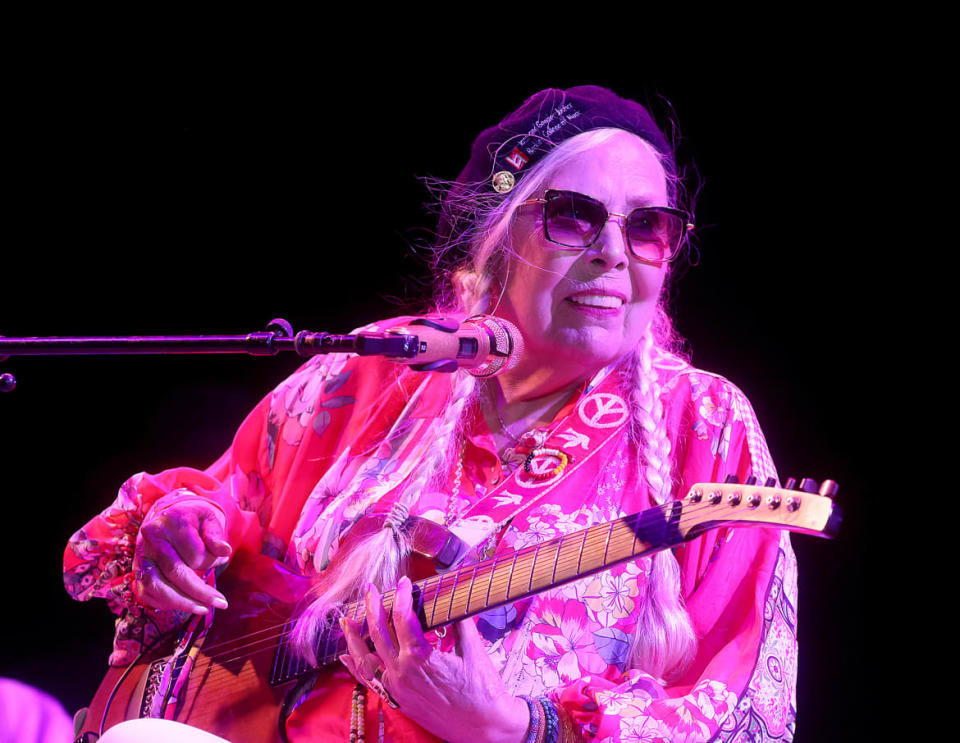
Joni Mitchell performs in concert during "Joni Jam" honoring her at Gorge Amphitheater on June 10, 2023 in George, Washington.
But this is big and bold and she’s never apologized for it, and nobody’s ever really called her out on it in a meaningful way.
Well, except for Miles Grier. But yes. I think, first of all, Joni Mitchell is intimidating. Let’s just be honest. She’s an intimidating presence. I’ve been talking about “the vortex of her charisma,” that phrase has been sticking with me. There’s a way that you’re drawn in and you want to be drawn in, and whether it’s as a fan or as someone working with her, writing about her, it’s scary to think, “She might be mad at me.” It’s almost a primal thing.
And as I try to talk about in that chapter, the moment in which she made the character of Art Nouveau, or the alter-ego of Art Nouveau, visible to us, was one in which a lot of very messed-up stuff was happening in the music scene and movies and in politics and culture, in the U.S. and beyond. I think we are definitely living in a moment of continued reckoning with America’s past in general, but particularly with the legacy of racism as it runs through North American popular culture. So this is connected to that. So I don’t think there was a way for me to avoid the subject or treat it with kid gloves or gloss over it, simply because this is 2024 and this is a time when we should be having these conversations.
Even when recent, previous biographies of Joni came out, it feels like it was a different time.
Yeah. But that said, it’s so tempting to say, “Well, it was a different time.” Last week was a different time.
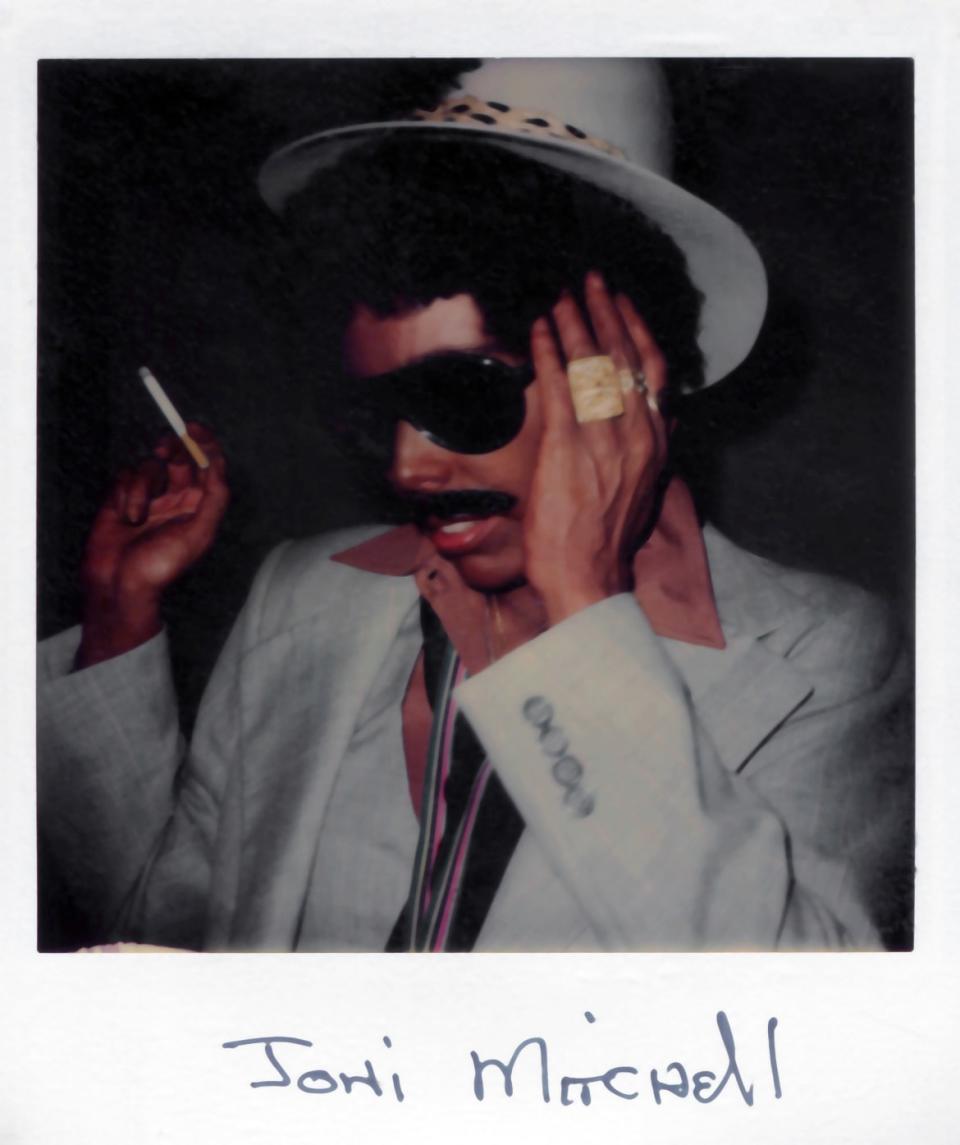
Joni Mitchell poses in blackface for Don Jaun's Reckless Daughter album cover 1977 in Los Angeles, California.
I’m not giving them a pass. I think they should have dealt with it.
No, but it’s true, it was a different time. But I felt like I had to deal with it, but then I also felt I had to be honest about how hard it was to deal with it, because these conversations are difficult to have. And I hope when people read the chapter, they recognize that this difficult conversation is necessary, and that it brings up a lot of unresolved emotions that all of us might have—all of us Joni Mitchell fans might have—no matter what our own personal identity is.
But, as I say in the end, it is disrespectful to not challenge an artist or a subject when the demand is there; that the challenge needs to happen. It would have been disrespectful, in my opinion, for me to gloss over the Art Nouveau story. And my reason to confront, not only the long life of Art Nouveau, but also her appropriations of and encounters with indigenous peoples as well, I just felt was important to consider both in a complex way, but also in a very uncompromising way. So ultimately, I think, her legacy can take it. And it is complicated, sure. But she should not have dressed as a Black man, period. … I am interested to see, in 2024, if she decides to address this period of her life, which extends for a long time. I will be listening.
I do want to deal with, before we finish, how Joni embraced burnishing her legacy very early on. We’ve gotten this victory lap in the last five years or so, but you also write about how she has long been curating her legacy the way a painter or an artist deals with their works to date.
Yes. And I believe that’s something she originally said, so I’m riffing on her own words, that she looked to the art world for a model, for how to do even those early greatest hits packages and onward. She was resistant to the idea of doing a hits package, when most artists of her generation were constantly generating hits packages. It had been proven, long before she agreed to do it, that a hits package could renew interest in your career, but the restless Joni wanted to keep moving forward. But when she did become convinced, I think she looked to the world of museums and galleries for a model. And I think, again, she also has this almost instinctive itch to do things in new ways and to make every action its own work of art. So she’s not going to be just signing it over to someone else. Because for Joni, even the smallest things, the smallest details, she almost neurotically hangs onto.
And I think that, for a woman artist, there is always a fear of erasure. Joni had seen many of her peers, her friends, either be completely erased, when it comes to somebody like a Judee Sill, or struggle with how they continued to exist in the realm. And I don’t see that kind of awareness necessarily in the men of that world.

Well, that’s their privilege.
Yeah, because they feel like their story is the official story. So in this, even though Joni is always resistant to be classified as a woman artist, I see very much a woman’s awareness that if I don’t do this, somebody’s going to mess it up.
You have to love an artist to spend so much time with them over the couple of years it takes to write a book like this. You made a choice not to speak to Joni, which I think was a wise one. Have you reflected at all on your own relationship with Joni and her work?
I’ll say this. I can’t say I know Joni Mitchell as a person. I’ve met her a couple of times and I certainly know many people who know her. That’s my first caveat. I feel it’s always important, as someone who encounters artists as part of my job, to always keep in mind that it’s rare that you actually get to know an artist as a journalist. You have these controlled, orchestrated encounters with them. But the Joni Mitchell I got to know through the archival work I did, through the interviews I did with other people, through my own listening and my own thought processes, in really taking this work into my body and my soul, is someone who I absolutely treasure.
Get the Daily Beast's biggest scoops and scandals delivered right to your inbox. Sign up now.
Stay informed and gain unlimited access to the Daily Beast's unmatched reporting. Subscribe now.

